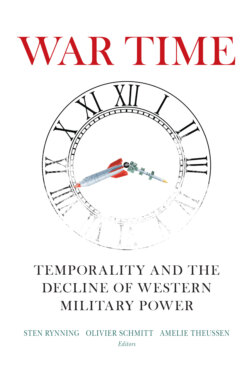Читать книгу War Time - Группа авторов - Страница 16
На сайте Литреса книга снята с продажи.
ONE The Modern State
ОглавлениеRise and Decline of Civic Militarism
SARAH KREPS
ADI RAO
In the January 2020 crisis between the United States and Iran, President Donald Trump took to his favorite medium, Twitter, to warn that “if Iran strikes any Americans, or American assets, we have … targeted 52 Iranian sites … some at a very high level & important to Iran & the Iranian culture, and those targets, and Iran itself, WILL BE HIT VERY FAST AND VERY HARD.”1 Pentagon officials swiftly walked back the threat, saying that “the laws of armed conflict” ruled out attacking cultural sites.2 It was not the first time President Trump had threatened aggressive measures with the promise of inflicting decisive and quick victory on an adversary. In 2017, he threatened North Korea with “a rain of ruin from the air, the likes of which has never been seen on this earth.”3
Although Trump has found the allure of the prospect of massive force and quick victory, the modern-day laws of wars have insinuated themselves as a veto player. And so it is that the United States has not actually “won” a war since World War II despite spending more on its military than the next nine countries combined. The changes are all for the good, since civilians have become more protected during wartime than they were during the strategic bombing campaigns of the 1940s, when indiscriminate bombing killed hundreds of thousands of civilians in Germany and Japan. In the Korean War, Army commander Matthew Ridgway observed that “Americans are not inclined by temperament to fight limited wars. As in the boxing ring, they want nothing less than a knockout. What red-blooded American could oppose so shining a concept as victory? It would be like standing up for sin against virtue.”4
Today, limited war is the norm. However, since states in the West are still uncomfortable with even this, leaders have reconciled the limited appetite for limited wars by shrouding the appearance of war altogether. One way they have done that is by limiting the sacrifice in both blood and treasure—by moving away from conscription and war taxes and removing the visible signs of war. In so doing, they have also moved away from “civic militarism,” in which a democracy draws in all of the resources available to it in the service of victory,5 with the public offering a check on the longevity of conflict precisely because of its investment in it.
This chapter focuses on the relationship between the public’s fiscal sacrifice in war and the conduct of that conflict. Using Charles Tilly’s focus on extraction and the development of the state as a point of departure,6 it suggests an endogenous relationship between the cost of war, the institutional shape of the state, and the war’s outcome. It examines the rise of the extractive state to its peak period from about 1850 to 1950, and then traces its decline. Taken together, this suggests that the notion of civic militarism, far from being a permanent feature of Western states, was more of an anomaly. Victor Davis Hanson’s notion of free peoples fighting wars by consensus takes the form of a quid pro quo starting in the nineteenth century, before it seemingly dissipates in the following century.7 During the period when civic militarism manifested itself, countries such as the United States sought to impose pace on war through large-scale and close-ended wars to advance desired outcomes. The decline of civic militarism may mean fewer large-scale wars, but also less civic engagement with conflict and a correspondingly diminished political ability to control the pace of wars.
To make these points, the chapter is organized according to three periods of war and state development. The first section considers the early history of war finance (c. 1200–1850) and details the most crucial developments for understanding what followed. In this early period, technological limits to extraction increasingly forced sovereigns to resort to debt to finance their military ventures. In other words, it was militarism without the civic underpinnings.
The second section considers the period between about 1850 and 1950 when the extractive state took center stage. Large-scale war meant large-scale revenue needs and large-scale commitment from domestic audiences. The extraction-coercion cycle referred to a dynamic in which a more powerful central state could coerce more revenue from the public; this in turn made it even more powerful, creating a link between the military and political development of the state.8 Although—or possibly because—extraction was coercive, the public whose resources were central to warfighting also took on a restraining function with respect to war, leading to the most visible manifestation of civic militarism.
That period, however, ultimately gave way to contemporary developments. The onset of limited war triggered limited appetite for what was perceived as unnecessary public sacrifice, which in turn created incentives for leaders to limit fiscal extraction. In this way the civic militarism apparent in the previous period unraveled.
The focus in this chapter is on the United States as a Western state that has been involved in and indeed led numerous large and small-scale wars, making it a worthy case study for understanding the relationship between war and the state. Examining state development in the context of extraction, we conclude that both the early state and the late state could be characterized as militaristic, and that civic militarism occurred during a comparatively brief interlude between them.
